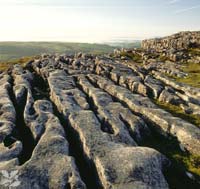Clints and grykes: 'karst' scenery in Yorkshire
 Those two interrelated terms, 'porous' and 'permeable' come together in Craven in the Yorkshire Dales, particularly around Malham, and again around the foot of Penyghent, near the village of Horton in Ribblesdale, and in the Peak District.
Those two interrelated terms, 'porous' and 'permeable' come together in Craven in the Yorkshire Dales, particularly around Malham, and again around the foot of Penyghent, near the village of Horton in Ribblesdale, and in the Peak District.Rainwater, ever so slightly acidic, and getting more so, runs off the high fells and hits limestone, through which it passes. On its way, it carves out swallow holes, like those between Malham Cove and Malham Tarn, and immense caverns - some with their rooves still intact, like those around Clapham, and some with their rooves collapsed, like the spectacular Gordale Scar, just outside the village of Malham, and the 'pot holes', Hull and Hunt Pot below Penyghent.
The clints and grykes at the top of Malham Cove and elsewhere in this area, show the ability of water, and frost, to exploit the cracks in the carboniferous limestone, again, a testament to the power of water.
Runnig water is always destructive when it is eroding. Fortunately for Craven, the action of water has been responsible for the carving out of some of the most impressive rock scenery in the British Isles.
 The term 'karst scenery' though was coined in the former Yugoslavia, where that type of scenery abounds.
The term 'karst scenery' though was coined in the former Yugoslavia, where that type of scenery abounds.Robert Leslie Fielding

0 Comments:
Post a Comment
Visit My Website<< Home